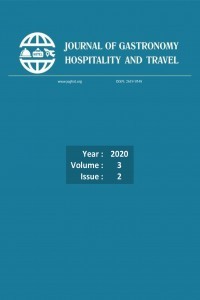EVALUATION OF HISTORICAL AND CULTURAL AREAS AS A TOOL FOR CITY MARKETING: CASE OF ESKİŞEHİR PROVINCE
EVALUATION OF HISTORICAL AND CULTURAL AREAS AS A TOOL FOR CITY MARKETING: CASE OF ESKİŞEHİR PROVINCE
City Marketing, Cultural Sphere Destination, Eskişehir,
___
- Altunbaş, H. (2007). Pazarlama İletişimi ve Şehir Pazarlaması, Selçuk İletişim, 4 (4).
- Ashworth, G., J. ve Voogd, H. (1990).Selling The City Belhaven Press, London.
- Atsız, O., & Kızılırmak, İ. (2017). Mardin’in Doğal ve Kültürel Çekiciliklerinin Destinasyon Pazarlaması Kapsamında İncelenmesi. Mukaddime, 8(1), 25-41.
- Bal, H. (1999), Kent Sosyolojisi(1.Baskı), Turhan Kitabevi, Ankara.
- Deffner A. & Liourius C. (2005). “City Marketing: A Significant Planning Tool For Urban Development In a Globalised Economy”, 45th Congress Of the European Regional Science Association”, Vrije University Amsterdam.
- Guo, G. Q., & Liu, Y. P. (2006). The new development of the research on city marketing. Contemporary Economy& Management, 28 (2), 5-12.
- Gümüş, N. (2017). Şehir Pazarlaması Bağlamında Üniversite Öğrencilerinin Şehre Yönelik Algılarının Belirlenmesi: Kastamonu İlinde Bir Araştırma. Pamukkale Üniversitesi Sosyal Bilimler Enstitüsü Dergisi, (26), 299-314.
- Ismail, S. & Mohd-Ali, N. A. (2011). The Imaging of Heritage Conservation in Historic City of George Town for City Marketing. Procedia Engineering, 20, 339-345.
- Karakullukcu, B. (2016). Eskişehir 2013 Türk Dünyası Kültür Başkentliği’nin Ulusal Basındaki Yansımalarının Şehir Pazarlaması Ekseninde Değerlendirilmesi. Yüksek Lisans Tezi. Eskişehir Osmangazi Üniversitesi Sosyal Bilimler Enstitüsü.
- Karataş, İ. A. (2017). Şehir Pazarlaması Açısından Marka Şehir Göstergelerinin Belirlenmesi Üzerine Bir Araştırma: Malatya Örneği. Doktora Tezi. İnönü Üniversitesi Sosyal Bilimler Enstitüsü, Malatya.
- Kavaratzis, M. (2004) From city marketing to city branding. Place Branding 1(1), 58-73.
- Kavaratzis, M. & Ashworth, G J. (2005). City branding: an effective assertion of identity or a transitory marketing trick?Tijdschrift Voor Economischeen Social eGeografie 96(5), 506-514.
- Kavaratzis, M. (2007). City marketing: The past, the present and some unresolved issues. Geography compass, 1(3), 695-712.
- Kavaratzis, M. &Ashworth, G. J. (2007). Partners in coffee shops, canals and commerce: Marketing the city of Amsterdam. Cities, 24(1), 16-25.
- Kotler, P, Asplund, C, Rein, I. & Heider, D. (1999). Marketing Places Europe. Pearson Education, London.
- Sadaklıoğlu, H. (2014). Şehir Pazarlaması Açısından Algılanan Pazar Odaklılık ile Algılanan Performans Arasındaki İlişki. Doktora Tezi. Sakarya Üniversitesi Sosyal Bilimler Enstitüsü.
- Sevim, M. A. (2019). Şehir Pazarlamasında Meydanların Etkin Yönetiminin Rolü ve Önemi: İstanbul Meydanları Üzerine Bir Araştırma. Doktora Tezi. Yıldız Teknik Üniversitesi Sosyal Bilimler Enstitüsü, İstanbul.
- ISSN: 2619-9548
- Başlangıç: 2018
- Yayıncı: Rahman TEMİZKAN
EVALUATION OF HISTORICAL AND CULTURAL AREAS AS A TOOL FOR CITY MARKETING: CASE OF ESKİŞEHİR PROVINCE
Simge ŞALVARCI, Fatmanur Kübra AYLAN
PERCEPTIONS AND PRACTICE OF TIPPING AMONGST DOMESTIC TOURISTS IN ZIMBABWE
Precious MAZHANDE, Vitalis BASERA, Oliver CHIKUTA, Musawenkosi TAPFUMA, Felicity NCUBE, Rudorwashe BAIPAI
MUTFAK DONATIMINDA GEREKÇELİ EKİPMAN ANALİZİ: HAZIRLIK EKİPMANLARI ÖRNEĞİ
FOOD CULTURE: GASTRONOMIC EXPERIENCES IN SINGAPORE
Vitalis BASERA, Godfrey MAKANDWA
GENÇLERİN DESTİNASYON SEÇİMLERİNİ ETKİLEYEN FAKTÖRLERİN BELİRLENMESİNE YÖNELİK BİR ARAŞTIRMA
TALAIOTIC CULTURAL HERITAGE AS A TOURISM RESOURCE IN THE BALEARIC ISLANDS
Asier BAQUERO, Rafael RIVELLES
TÜRKİYE’NİN AV TURİZMİ POTANSİYELİ KONUSUNDA BİR DEĞERLENDİRME
